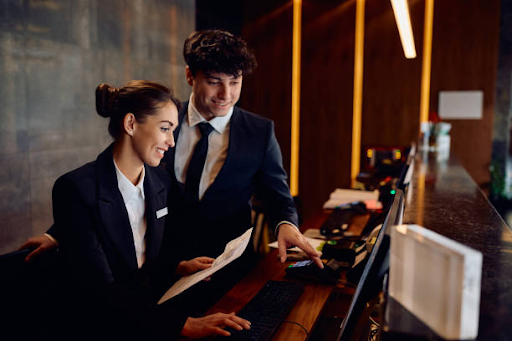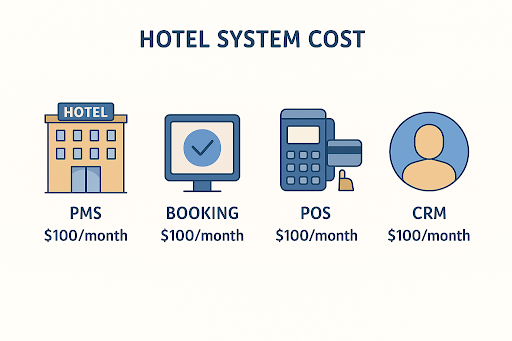Hotel Management System – Streamlined Operations, Better Guest Experience
After the pandemic, Vietnam’s tourism has recovered strongly. National statistics show international and domestic travelers growing at double digits yearly, leading to an explosion of thousands of new properties. However, competition is fierce—just a 10-minute delay at check-in can trigger a 1-star review and a lost customer.
In reality, many hotels still operate manually with paper books or Excel. The result: double bookings, prolonged check-in, slow housekeeping updates, and clunky payments. Not only are guests dissatisfied, but revenue also slips through the cracks.
⇒ This is when a modern hotel management system becomes the key: synchronizing the entire workflow—from booking, check-in/out, housekeeping to payment—helping hotels cut costs and elevate the guest experience.

📌 Learn more about hotel management software: See details here
Why do hotels need a unified management system?
In the digital era, hotels don’t just “sell rooms” — they sell experiences. Cumbersome processes waste staff time and frustrate guests.
Common problems without a system:
- Booking: Overbooking because website, OTA, and walk-in data aren’t synchronized.
- Check-in/out: Manual procedures take 10–15 minutes per guest.
- Housekeeping: Staff don’t know which rooms are ready → guests wait.
- Payment: Manual reconciliation, error-prone, lacking transparency.
Benefits with a unified system:
- Real-time booking: eliminate double bookings/overbooking.
- Fast check-in/out: complete in 2–3 minutes.
- Continuous housekeeping updates: rooms ready when guests need them.
- Transparent payments: support cash, cards, e-wallets.
📊 Statista 2023: 78% of travelers value hotels with fast check-in — a key factor in retention.

Key features of a hotel management system
An effective HMS should cover the end-to-end journey — booking, check-in/out, housekeeping, and payment.
1. Smart booking
Booking is the start of the guest journey; if it’s poorly handled, guests switch to competitors.
- Receive bookings from multiple channels (website, OTA, direct).
- Sync room status in real time to avoid double bookings.
- Send email/SMS confirmation instantly.
2. Fast check-in / check-out
Arrival and departure are key touchpoints that shape reviews.
- Streamlined steps — only 2–3 actions.
- Update room status immediately when guests depart.
- Support online check-out or self-service kiosks.

3. Efficient housekeeping
Housekeeping can account for up to 40% of hotel operations. Without a system, ready-room updates lag.
- Update statuses: vacant, occupied, cleaning.
- Schedule cleaning, notify staff.
- Minimize guests waiting for unclean rooms.
4. Transparent payments & reconciliation
Payments shape both experience and brand trust.
- Support multiple methods (cards, e-wallets, QR).
- E-invoice; accounting integration.
- AR management & real-time income/expense reports.

→ Thanks to these features, an HMS not only optimizes operations but also delivers a smooth, convenient guest experience.
Benefits of deploying a hotel management system
For hotels
- Reduce operating costs by 20–30%.
- Improve coordination across front desk, housekeeping, accounting.
- Manage multi-property chains on a single platform.
For guests
- Easy booking, fast check-in/out.
- Clean rooms, ready on time.
- Professional service, higher satisfaction.

Manual management vs. hotel management system
Manual management used to be the “cost-saving” solution for small hotels. But as booking volume and scale grow, Excel quickly shows limitations.
| Criteria | Manual (Excel / log books) | Hotel management system |
|---|---|---|
| Booking | Prone to double bookings, slow updates | Multi-channel sync, real time |
| Check-in/out | 10–15 minutes/guest | 2–3 minutes, simple steps |
| Housekeeping | Slow notifications, low transparency | Real-time, clear status |
| Payment | Manual, error-prone | Automated, multi-method |
| Reporting | Hard to analyze, error-prone | Instant, visual |
→ Clearly, an HMS elevates service and saves substantial operating costs.
Implementation cost – main factors
Many hoteliers hesitate fearing “high costs”. In fact, costs depend on scale and features — and it’s a long-term investment.
1. Number & complexity of features
- Basic: booking, housekeeping, income/expense reports.
- Advanced: OTA, CRM, AI pricing, mobile app.
2. Deployment platform
- Web App: lower cost, suitable for internal management.
- Mobile App: convenient for remote managers.
- Multi-platform: highest cost, best for chains.
3. Scalability & security
- Multi-branch chains → need scalable systems.
- Guest data security → comply with ISO/GDPR.

Deployment process at TheApp4U
Many hoteliers worry about complex deployments causing service disruption. In practice, TheApp4U standardizes a 6-step process for smooth, non-disruptive rollouts.
Survey & Requirements
- Work with owners and departments (FO, HK, accounting).
- Capture current process & pain points.
Analysis & Planning
- Define feature scope.
- Estimate timeline & budget.
UI/UX Design
- Simple interfaces for non-IT staff.
- Demo for feedback.
Development & Integration
- Core features (booking, housekeeping, reporting).
- Integrate OTA, CRM, payments as needed.
Testing & Go-live
- Test with simulated data.
- Pilot 1–2 weeks on site.
- Official go-live.
Training & Post-deployment Support
- Train front desk & managers.
- Docs + videos; 24/7 support.
Commitments & Support
Deployment is just the beginning. Long-term partnership keeps operations stable and growing.
- Training & knowledge transfer for FO & managers.
- 24/7 technical support via hotline/email/ticket.
- Warranty & maintenance 12–36 months.
- Upgrades & expansion for new branches.
- Security & technology updates to latest standards.
⇒ With TheApp4U, you’re not just buying software — you’re gaining a strategic technology partner.
Integrations & Future roadmap
TheApp4U’s HMS is ready not only for today but for the next 3–5 years:
- OTA: Booking, Agoda, Traveloka.
- CRM & Loyalty.
- AI Pricing for seasonal/competitive optimization.
- IoT hotel tech: room sensors, smart locks.
FAQ – Frequently asked questions
From our consulting experience, hoteliers often ask: is the system easy, how long to train, data security, cost, and timeline? Here are detailed answers.
1. Is the system hard to use?
This is a common concern, especially for smaller properties. Rest assured:
- Intuitive UI: minimalist, easy to grasp, even for non-tech staff.
- Friendly language: Vietnamese & English supported.
- Simple flows: booking or check-in/out in 2–3 steps.
2. Do we need many training sessions?
No. Usually 1–2 sessions:
- Session 1: core flows (booking, check-in/out).
- Session 2: housekeeping, reports, reconciliation.
- Docs + videos for review; extra online training for large multi-shift hotels.
3. Does it support multi-property chains?
⇒ Yes. This is a core strength.
- All branches sync on one platform.
- Managers track occupancy and revenues per property in real time.
- Granular permissions by branch/department (FO, HK, accounting).
Example: A 5-property chain in Hanoi uses TheApp4U to monitor financials and room status across the system via a single dashboard.
4. Does it support online payments?
⇒ Yes. The system integrates popular gateways:
- E-wallets: Momo, ZaloPay, VNPay.
- International cards: Visa, MasterCard.
- Bank transfer.
- QR code for domestic & international guests.
It also supports automatic e-invoicing to reduce errors and save reconciliation time.
5. Is guest data secure?
⇒ Yes. Guest data contains sensitive info (passports, phone numbers, credit cards). TheApp4U applies:
- End-to-end encryption.
- Granular access control.
- Scheduled backups.
- Compliance: ISO 27001, GDPR, PCI DSS.
6. How much does it cost?
⇒ Depends on scale and features:
- Small hotels (10–20 rooms): basic cost from tens of millions VND.
- 3-star (50–100 rooms): OTA, accounting, CRM → 3–4× higher.
- 4–5-star chains: higher investment, but better revenue and lower long-term OpEx.
Example: An 80-room hotel in HCMC reduced manual data entry costs by 40% and raised room revenue by 15% after unified OTA management.
7. How long is the deployment?
- Basic: 2–4 weeks (booking, housekeeping, reporting).
- Full solution: 6–8 weeks (multi-property, OTA, CRM, online payments).
- Process: survey → configuration → testing → training → go-live. Operations won’t be disrupted thanks to parallel pilots and on-site support.
Conclusion
In hospitality, guest experience is the edge. Fast check-in, ready rooms, transparent payments bring guests back.
👉 With TheApp4U Hotel Management, your hotel will: synchronize all operations, raise guest satisfaction, save costs and optimize revenue.
📞 Contact TheApp4U for a free consultation & live demo.

 English
English
 Tiếng Việt
Tiếng Việt
Add New Comment